new posts in all blogs
Viewing: Blog Posts Tagged with: purse, Most Recent at Top [Help]
Results 1 - 16 of 16
How to use this Page
You are viewing the most recent posts tagged with the words: purse in the JacketFlap blog reader. What is a tag? Think of a tag as a keyword or category label. Tags can both help you find posts on JacketFlap.com as well as provide an easy way for you to "remember" and classify posts for later recall. Try adding a tag yourself by clicking "Add a tag" below a post's header. Scroll down through the list of Recent Posts in the left column and click on a post title that sounds interesting. You can view all posts from a specific blog by clicking the Blog name in the right column, or you can click a 'More Posts from this Blog' link in any individual post.

By: KatherineS,
on 8/14/2015
Blog:
OUPblog
(
Login to Add to MyJacketFlap)
JacketFlap tags:
History,
culture,
Nazi,
VSI,
Very Short Introductions,
psychotherapy,
Freud,
psychoanalysis,
fascism,
*Featured,
Science & Medicine,
Psychology & Neuroscience,
VSI online,
cultural fantasies,
Daniel Pick,
Psychoanalysis: A Very Short Introduction,
Add a tag
Daniel Pick, author of Psychoanalysis: A Very Short Introduction, introduces psychoanalysis, discusses its role within history and culture and tells us how psychoanalysis is used today. How has psychoanalysis developed from the late nineteenth century?
The post Introducing psychoanalysis appeared first on OUPblog.

By: Alice,
on 2/26/2012
Blog:
OUPblog
(
Login to Add to MyJacketFlap)
JacketFlap tags:
History,
Nazi,
world war I,
hitler,
This Day in History,
Munich,
Europe,
Mein Kampf,
Adolf Hitler,
treason,
*Featured,
hitler’s,
higher education,
Weimar Republic,
this day in world history,
German republic,
putsch,
adolf,
mein,
traitors,
Add a tag
This Day in World History
February 26, 1924
Adolf Hitler’s Treason Trial Begins in Munich
On February 26, 1924, Adolf Hitler and nine associates stood trial in a Munich courtroom. The charge was treason — they were accused of trying to overthrow the German republic. That day, Hitler turned the tables to accuse the German leaders who had surrendered in 1918, ending World War I, and created the republican government he so despised: “There is no such thing as high treason against the traitors of 1918,” he proclaimed.
Germany in the early 1920s was deeply divided. Right-wing nationalists like Hitler bitterly opposed both the republican government and the leftists and Communists who struggled with them for power. These nationalists were also inspired by the example of fascist Benito Mussolini, who had seized power in Italy. Perhaps, they thought, they too could gain power with forceful action.

Hitler’s hopes to launch a national revolt were buttressed by the apparent support of three Bavarian officials. Hoping to force them to join his cause, he staged a putsch, or coup, at a political meeting in a Munich beer garden. Declaring “The revolution has begun,” he had armed thugs from his National Socialist (Nazi) party use the threat of force to convince the three to join him. The next day, however, the three had police fire on a Nazi march, and had Hitler and others arrested.
The trial received coverage across Germany, which Hitler used to his advantage. He denounced the republican government. He denounced the three Bavarian leaders for cowardice. He remained defiant down to the guilty verdict. In his closing speech, Hitler offered a prophetic call: “The man who is born to be a dictator is not compelled: he wills it.”
Sympathetic judges gave Hitler a sentence of only five years. He served only eight months of it. He spent his time in prison writing the first half of Mein Kampf¸ his political manifesto, which detailed his anger at “the traitors of 1918” and set forth his extreme racial views. He also used his time in prison to plan a second — and more successful — takeover of Germany’s government.
“This Day in World History” is brought to you by USA Higher Education.
You can subscribe to these posts via RSS or receive them by email.



By: Kirsty,
on 10/17/2011
Blog:
OUPblog
(
Login to Add to MyJacketFlap)
JacketFlap tags:
History,
Biography,
Videos,
Holocaust,
Germany,
World War II,
Nazi,
Multimedia,
Military,
Europe,
Peter Longerich,
*Featured,
SS,
heinrich himmler,
himmler,
SS-Reichsführer,
longerich,
heinrich,
reichsführer,
reich,
Add a tag
As head of the SS, chief of police, 'Reichskommissar for the Consolidation of Germanness', and Reich Interior Minister, Heinrich Himmler enjoyed a position of almost unparalleled power and responsibility in Nazi Germany. Perhaps more than any other single Nazi leader aside from Hitler, his name has become a byword for the terror, persecution, and destruction that characterized the Third Reich.


By: Kirsty,
on 4/11/2011
Blog:
OUPblog
(
Login to Add to MyJacketFlap)
JacketFlap tags:
jerusalem,
jewish,
Military,
Hitler,
israel,
argentina,
Latin America,
Europe,
vatican,
*Featured,
adoly eichmann,
gerald steinacher,
hannah arendt,
nazis on the run,
riccardo klement,
eichmann,
riccardo,
eichmann’s,
steinacher,
klement,
History,
Holocaust,
Germany,
Nazi,
Add a tag
By Gerald Steinacher
April 11, 1961 marked the beginning of the trial against Adolf Eichmann in Jerusalem. In the course of the trial, the world came face to face with the reality of the Holocaust or what the Nazis called the “final solution of the Jewish problem” – the killing of 6 million people. Newspapers around the world published thousands of articles about Eichmann and his role in the Holocaust. But what none of the international journalists touched upon was probably the most intriguing aspect of Eichmann’s story: the way in which he, the bureaucrat of the Holocaust, managed to escape justice soon after the war and flee to Argentina.
The prominent philosopher Hannah Arendt, who closely followed the trial in Israel, was one of those who wondered why Eichmann’s escape never attracted more international attention. In her famous book Eichmann in Jerusalem she wrote “the trial authorities, for various reasons, had decided not to admit any testimony covering the time after the close of the war.” It seems that there was a conscious effort to restrict the dissemination of information on how Eichmann managed to escape to Argentina. This part of his story was to remain largely a secret, which took historians more than fifty years to uncover.
We now know what the Israeli authorities kept hidden during the Eichmann trial: the involvement of Vatican circles, Western intelligence services, various governments and the International Committee of the Red Cross in the escape of Eichmann and thousands of other Nazis, war criminals, and Holocaust perpetrators. A picture has emerged that raises many uncomfortable questions. It is clear that the agencies involved knew exactly what they were doing, but were able to justify the decisions they made and the actions they took with the Cold War. After all, as the Third Reich lay in ruins, the only enemy left for the Western Powers was the communist Soviet Union. In the eyes of the Catholic Church, communism was a ‘godless, deadly enemy’, even worse than Nazism.
After laying low in Germany for several years, in 1950 Adolf Eichmann decided to immigrate to Argentina. He used a tried route through Italy, where he acquired a new identity as Riccardo Klement, a South Tyrolean from Bolzano, and a travel document from the Red Cross. In Italy he was helped by the Vatican Aid Commission for Refugees, in cooperation with a small group of catholic priests, former SS comrades and some Argentinean officials. The ease with which he reached Argentina was also the result of Western intelligence services, such as the CIA and the German BND, turning a blind eye to where Eichmann was hiding. Research suggests that they knew of his new identity as Riccardo Klement, but ignored the information. But why would the Israeli government be so careful not to reveal any of this during Eichmann’s trial? The true reasons are unclear, but it is possible that Israelis simply did not want to embarrass governments and institutions who were now their allies.
Riccardo Klement’s life on the run came to an abrupt end in May 1960, when he was kidnapped by Israeli government agents just outside of his home in Buenos Aires and taken to Jerusalem: “I, the undersigned, Adolf Eichmann, hereby declare out of my own free will that since now my true identity has been revealed, I see clearly that it is useless to try and escape judgment any longer.” Eichmann had to stand trial and in the process the world came to know the horrible details about the treatment of Jews in Nazi Germany, from their forced emigration to centrally- planned industrialized genocide. But the world had to wait 50 years longer to finally learn the truth about how some of the worst Holocaust perpetrators fled justice and who were the institutions helping them do it.
0 Comments on Eichmann in Jerusalem as of 1/1/1900

By: Lauren,
on 8/12/2010
Blog:
OUPblog
(
Login to Add to MyJacketFlap)
JacketFlap tags:
History,
Holocaust,
A-Featured,
Western Religion,
Nazi,
jewish,
World History,
persecution,
judenpolitik,
Peter Longerich,
Add a tag
Peter Longerich is Professor of Modern German History at Royal Holloway University of London and founder of the College’s Holocaust Research Centre. His book, Holocaust: The Nazi Persecution and Murder of the Jews, shows the steps taken by the Nazis that would ultimately lead to the Final Solution. He argues that anti-Semitism was not a mere by-product of Nazi political mobilization or an attempt to deflect the attention of the masses. Rather, from 1933 onwards, anti-Jewish policy was a central tenet of the Nazi movement’s attempts to implement, disseminate, and secure National Socialist rule. In the excerpt below Longerich analyzes the state of Jewish citizens of Germany right before the start of the war.
Once the third anti-Semitic wave had reached its peak, the National Socialist policy of total segregation of the German Jews had now been realized by extensive measures in all spheres of life. The Jews, excluded from economic life, led a wretched existence in complete social isolation: they lived on savings deposited in blocked accounts, from which sums for their immediate needs could be withdrawn only with permission from the Gestapo, Jewish welfare aid, or the minimal wages from Jewish work deployment. Jews could only be economically active for others Jews, for example as Rechtskonsulenten (legal advisers)…
According to the results of the May 1939 census, there were still 213,930 ‘faith Jews’ (i.e. members of synagogues) living in the Old Reich Territory. The concentration of Jews in cities had intensified. There was a disproportionately high level of old people among the Jews living in Germany: 53.6 percent were over 50, 21.6 per cent over 65…As a result of emigration there was a considerable surplus of women (57.5 percent). Only 15.6 percent of the Jews counted in May were in work, almost 71 percent of all Jews over 14 came under the category of the ‘unemployed self-employed’. There were also 19,716 people who did not belong to the Jewish religious community (more than half were Protestants), but who were graded as ‘racial Jews’, as well as 52,005 ‘half-breeds grade I’ and 32,669 ‘half-breeds grade II’.
At the instigation of the NS state the compulsory ’self-administration’ of the Jewish minority had been rendered uniform: the religious associations became branches of the Reich Association…which also took over the whole of Jewish care, health, and schooling, as well as all still existing Jewish organizations. The Reich Association…thus became the organization that controlled the isolated Jewish sector. Apart from this, the only remaining autonomous Jewish organization was the Jewish Cultural Association.
If the Reich Deputation of the Jews in Germany, now dissolved, had been a holding organization of independent Jewish organizations and communities, in the new, hierarchical organization autonomy was as good as excluded…On the social level their task now no longer consisted of supporting needy Jews alongside state care; falling back entirely on their own resources, they now also had to undertake the care of the Jews who were completely excluded from the state social system. In this way the regime had not only discharged responsibility and expenses; it has also ensured that the Jewish minority was almost completely isolated from the rest of the population and it had at its disposal a compulsory organization that it made responsible for the execution of official orders.
This set-up, using a Jewish organization to control an isolated Jewish sector and making it responsible for the implementation of the regime’s anti-Jewish policies, marked the birth of a new and perfidious form of organization of Judenpolitik: the<

By: Rebecca,
on 4/29/2008
Blog:
OUPblog
(
Login to Add to MyJacketFlap)
JacketFlap tags:
History,
Germany,
Geography,
A-Featured,
Nazi,
camp,
map,
Ben's Place of the Week,
atlas,
Concentration Camp,
Dachau,
Munich,
memorials,
amper,
swelled,
crematorium,
bavaria,
attest,
Add a tag
Dachau, Germany
Coordinates: 48 15 N 11 26 E
Population: 40,570 (2007 est.)
The old village and sixteenth-century palace here attest to the fact that Dachau, located just north of Munich on the Amper River in Upper Bavaria, has been inhabited for centuries. In spite of such history however, it will forever be remembered as the site of the first Nazi concentration camp. When it was established in March 1933, the former munitions factory held just under 5,000 prisoners but in a little more than a decade, the population had swelled to more than 14 times that number. American forces liberated Dachau on April 29, 1945. Visitors who enter what remains of the walled camp today will find the foundations of numerous barracks, the crematorium, gas chambers, a museum in the main building, and numerous memorials scattered around the grounds.

Ben Keene is the editor of
Oxford Atlas of the World. Check out some of his
previous places of the week.
ShareThis

By:
Maggie Summers,
on 2/25/2008
Blog:
A Latte a Day
(
Login to Add to MyJacketFlap)
JacketFlap tags:
reading,
journal,
shopping,
Maggie Summers,
purse,
bag,
"children's illustration",
"pen and ink",
bag,
Maggie Summers,
"pen and ink",
purse,
"children's illustration",
Add a tag
 I headed to Parables for book browsing and grabbed one off the shelf to sketch. I haven't read it, but liked the cover so it became part of my prop along with my new handbag and leather pencil case which I carry with me at all times. I love to capture moments whenever I have the opportunity.
I headed to Parables for book browsing and grabbed one off the shelf to sketch. I haven't read it, but liked the cover so it became part of my prop along with my new handbag and leather pencil case which I carry with me at all times. I love to capture moments whenever I have the opportunity.
Today it rained and snowed simutaneously and was relatively warm (low 40's) and you needed and umbrella however by the time I left the office for home it had turned to freezing and I had to scrape the windows. I cranked up the heat and my feet have finally thawed. Not a good idea to stand in snow and ice while scraping your windows. I should have had boots on but who was to know?


I was tagged by the lovely Robyn to post a pic of my purse and what's currently inside. So, let's see...
Like the purse? I love the metallic color and the rings screamed "buy me!"
Inside, we've got:
* My adorable pink cell phone. (So cute!)
* Wallet (It's new. My old one used to have a butterfly on it.)
* Clinique brush. You know, in case I get the urge to brush my hair in public. Right.
* 3 lipglosses because I'm obsessed with them.
* A digital voice recorder for notes, article ideas, etc. because my handwriting is horrible.
* Hand sanitizer spray. Apparently, there are lots of germs out there!
* Pepper spray. So don't try to take my purse.
* 3 packs of gum because I'm an addict.
* Tic Tacs. Aren't those in everyone's purses?!
* Tulip notepad. In case digital voice recorder fails.
* Handy mirror.
* Oversized sunglasses.
* My adorable new gloves. And yes, you need gloves in Florida!
So there we go! I tag any blog readers who want to participate! :)

By:
Claire Louise Milne,
on 12/4/2007
Blog:
Needle Book
(
Login to Add to MyJacketFlap)
JacketFlap tags:
flowers,
sewing,
crafts,
purse,
bag,
velvet,
show,
sew,
floral,
show,
bag,
purse,
floral,
sew,
velvet,
Add a tag
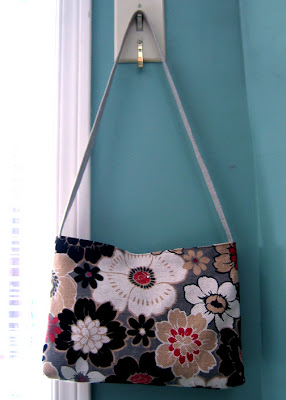 I spied this fabric at the Designer Fabric Outlet store on Queen West (1360 Queen St. W, between Dufferin and Landsdowne) recently. This store is amazing, they have, if anything, too much choice. My favourite part is that all the fabric is in small swatches on hangers, organized by fiber, colour and pattern, and so it's very easy to browse through. My friend Sarah and I spent ages in there. Don't forget to go upstairs for extra fabric on bolts - and even more choices.
I spied this fabric at the Designer Fabric Outlet store on Queen West (1360 Queen St. W, between Dufferin and Landsdowne) recently. This store is amazing, they have, if anything, too much choice. My favourite part is that all the fabric is in small swatches on hangers, organized by fiber, colour and pattern, and so it's very easy to browse through. My friend Sarah and I spent ages in there. Don't forget to go upstairs for extra fabric on bolts - and even more choices.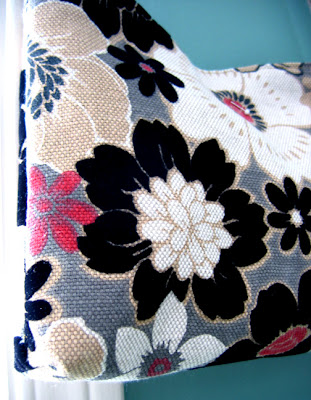 As promised I'm showcasing some of the things I'm making for my table at the Artisan's Gift Fair this Sunday. I thought this fabric was really gorgeous and perfect for a evening bag. I love the colour scheme of tan, grey, white, black and red. Also the black parts of the flowers are velvet and very soft. Since I'm not home I don't have all my fabric with me, so it's lined with some of the linen I bought. Usually linen is a bit pricey for a lining but since I don't have anything else with me, this bag is just that much more special. There's a pocket inside, and I'll be adding a snap or button clasp when I get home.
As promised I'm showcasing some of the things I'm making for my table at the Artisan's Gift Fair this Sunday. I thought this fabric was really gorgeous and perfect for a evening bag. I love the colour scheme of tan, grey, white, black and red. Also the black parts of the flowers are velvet and very soft. Since I'm not home I don't have all my fabric with me, so it's lined with some of the linen I bought. Usually linen is a bit pricey for a lining but since I don't have anything else with me, this bag is just that much more special. There's a pocket inside, and I'll be adding a snap or button clasp when I get home.
I have a dressy black dress that needs something just like this to go with it! Just one question, should the closure be a snap or button? A snap is more practical and easier to open and close but a button could be prettier. What do you think?

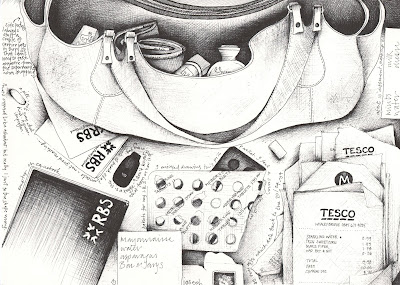 I've been shamed into clearing my bag out. Yesterday, in work, I had to share a locker as there were not enough to go around. My bag does not zip up, apart from the pocket in the middle, and therefore you can see everything inside. Very embarrassing. Bulging full of old sweet wrappers, chewy, bits of paper, receipts, letters, vouchers, train tickets etc etc. All of which belong in the bin. Why do I carry all this rubbish around with me? On so many levels.
I've been shamed into clearing my bag out. Yesterday, in work, I had to share a locker as there were not enough to go around. My bag does not zip up, apart from the pocket in the middle, and therefore you can see everything inside. Very embarrassing. Bulging full of old sweet wrappers, chewy, bits of paper, receipts, letters, vouchers, train tickets etc etc. All of which belong in the bin. Why do I carry all this rubbish around with me? On so many levels.
 Purse #8. This one is drawn from memory. It's the one that got away. The one I didn't buy. I have a list of purchases that I wish I'd made. Missed opportunities that'll probably bug me for the rest of my days; that mirror with a beautiful carved frame from a charity shop in Didsbury, a gorgeous green tweed jacket by Per Una, an automaton from an antique shop in Canada, and those Converse (that were the exact same colour as my sepia drawing) which I saw in a shop in Norwich - and they were on half price sale. Damn. Funny the things that make it through to the long term memory, isn't it?
Purse #8. This one is drawn from memory. It's the one that got away. The one I didn't buy. I have a list of purchases that I wish I'd made. Missed opportunities that'll probably bug me for the rest of my days; that mirror with a beautiful carved frame from a charity shop in Didsbury, a gorgeous green tweed jacket by Per Una, an automaton from an antique shop in Canada, and those Converse (that were the exact same colour as my sepia drawing) which I saw in a shop in Norwich - and they were on half price sale. Damn. Funny the things that make it through to the long term memory, isn't it?
More purses and stuff
HERE.
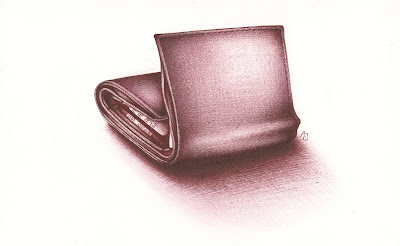 I've been drawing quite a lot this week. Had a week off work which helps. I was going to keep this until tomorrow to post. But I can't wait until tomorrow. I'm proud of this one and I want to post it now. Hope you like it too. It's my wallet.
I've been drawing quite a lot this week. Had a week off work which helps. I was going to keep this until tomorrow to post. But I can't wait until tomorrow. I'm proud of this one and I want to post it now. Hope you like it too. It's my wallet.
 Purse #6 above. A little friend for purse #4 below. As me and Bob Ross have said before 'everybody needs a friend'.
Purse #6 above. A little friend for purse #4 below. As me and Bob Ross have said before 'everybody needs a friend'.
 See my purse collection, so far, HERE.
See my purse collection, so far, HERE.
 Purse#6 above. A little friend for purse#4 below. As I've said before; everybody needs a friend.Yes, I'm loosing grip of reality.
Purse#6 above. A little friend for purse#4 below. As I've said before; everybody needs a friend.Yes, I'm loosing grip of reality.

 I am really happy with the colours I've achieved in this drawing however I'm not sure about the composition. I drew around the purse to get the shape down onto the paper and now I wish I'd pushed the side in first. Damn.
I am really happy with the colours I've achieved in this drawing however I'm not sure about the composition. I drew around the purse to get the shape down onto the paper and now I wish I'd pushed the side in first. Damn.
I bought this purse specifically to draw. It was very cheap. This kind of purchase always causes me a moral dilemma. Whilst I adore a bargain the guilt creeps into my mind. How can they make these things so cheap? Where was it made? By whom? Adult or child? How much were they paid? Were they paid? What were the conditions like? How much damage to the environment was caused just so I can get a bargain like this? Am I a bad person? Welcome to my world!

By:
Claire Louise Milne,
on 4/5/2007
Blog:
Needle Book
(
Login to Add to MyJacketFlap)
JacketFlap tags:
sewing,
knitting,
crafts,
blue,
lattice,
purse,
board,
knit,
felting,
bamboo,
embroidery,
cork,
Add a tag




















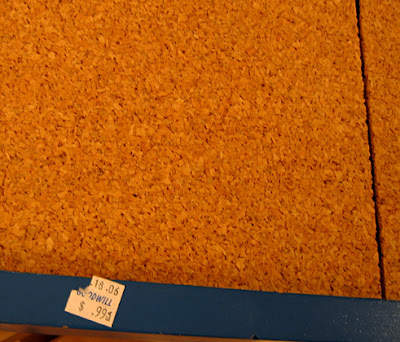
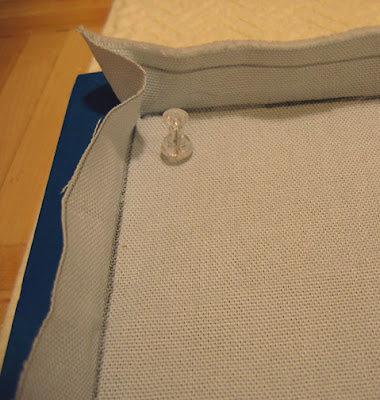
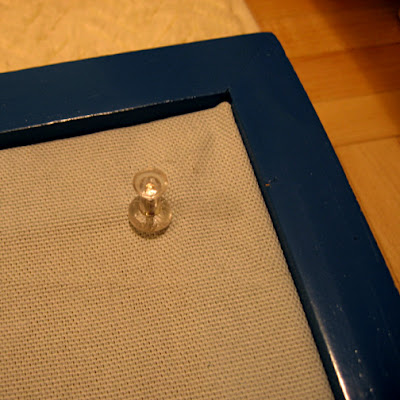

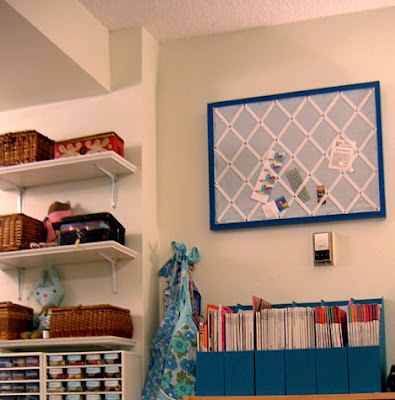
Wonderful!
Beautiful!
Maggie, this is such a lovely drawing and your colours are so rich, enjoy that bag.
Great composition! How did you do that wonderful surface on the purse? Looks so perfect.
Shirley
http://www.paperandthreads.com
I love this little sketch!
sweet sketch Maggie
Thanks for stopping by my photoblog. I enjoyed your comments. You like Shel Silverstein...I do too. I searched out a rare copy of "Uncle Shelby's ABZ Book". It's a hoot. It's a child's primer. I will never forget the letter E. He say's something like this... "E is for Ernie, a genie who lives in the ceiling. Ernie likes to eat eggs. Would you like to feed Earnie?" How funny is that?